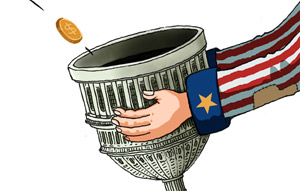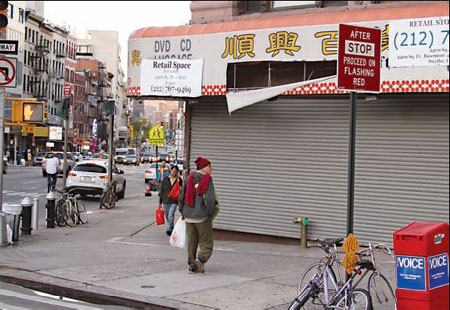US Chinatowns face risk of disappearing: year-long study warns
Updated: 2013-10-15 10:58
By Amy He in New York (China Daily USA)
|
||||||||
|
A street corner in New York City's Chinatown, where high-end gentrification may be threatening to change a neighborhood's character forever. Hu Haidan / China Daily |
Like other ethnic neighborhoods in large US cities, Chinatowns are at risk of disappearing due to accelerated gentrification, according to a new report.
The Asian American Legal Defense and Education Fund (AALDEF) surveyed Chinatowns in Boston, New York and Philadelphia and found that the Asian populations in all communities are decreasing while rent and median housing value are increasing.
In the yearlong study conducted in 2011, AALDEF gathered information on land-use, which showed "the interplay of residential, commercial, and industrial uses in Chinatowns and pinpoints where high-end, luxury development areas are concentrated and emerging," said the report.
Luxury condominiums are taking over areas that were previously used as industrial spaces. "The decline of manufacturing has contributed to gentrification as many former industrial spaces have become high-end condos," wrote the authors of the study.
The addition of luxury condos also brought a change in the demographic of the communities' residents, from families and working immigrants to non-family households, including students, young professionals, artists and designers "who often make the neighborhoods 'hip,'" AALDEF said in the report.
The organization found that in Boston's Chinatown, the median household income for non-Hispanic whites in Chinatown increased to $84,255 between 2005 to 2009 from $40,554 in 2000, while the median income for Asians dropped to $13,057 from $16,820 in the same time period. According to census numbers, the neighborhood saw a 99 percent increase in its white population between 2000 and 2010, while the Asian population increased by 12 percent.
A similar shift is happening in New York's Chinatown, though the results of gentrification are not as obvious because Manhattan's Chinatown is larger than those in Boston or Philadelphia, according to the study. The white population increased by 19 percent in a decade and the Asian population dropped 11 percent between 2000 and 2010. The value of houses in surged in 2010 to $687,388 from $167,917 in 2000.
Family households in New York's Chinatown are on the decline, which is a "revealing gentrification indicator," the report said. The number of family households decreased by 12.6 percent in a decade, while non-family households increased by 21.4 percent.
In Philadelphia, the white population increase was the most drastic at 233 percent, compared to the 73 percent increase of the Asian population, according to the study.
The report's authors wrote that many factors contributed to the gentrification of these communities, including institutional expansion as well as significant rezoning and commercial development. Boston's Chinatown had to fight Tufts University and the New England Medical Center expanding; New York dealt with a shrinking garment industry after 9/11, which made way for million-dollar lofts; and office and factory conversions into hotels in preparation for the 2000 Republican National Convention changed Chinatown's landscape in Philadelphia.
The study showed that real estate developments in the communities have often neglected the needs of Chinatown residents and workers. Bethany Li, staff attorney at AALDEF and an author of the report, said that New York's Chinatown consists overwhelmingly of small businesses - 94 percent - so developers' obsessions with building hotels, for example, is harmful for the community.
"These small businesses are very focused on selling day-to-day goods that residents and workers in the neighborhood use," said Li. "So the fact that there are so many hotels in the neighborhood seems a little inconsistent, especially as developers to promote the neighborhood as a place for tourists, because in fact, residents are needing a lot more resources than tourists are."
To help preserve the Chinatowns, the authors recommended that funding be directed toward building more low-income and senior housing units for residents, as well as giving subsidies to small businesses.
"Urban planners and preservationists often tout the need for neighborhoods with distinctive cultures," the authors wrote. "Yet while public and private interests outwardly celebrate neighborhoods like Chinatown, the residents who create that culture are often forgotten."
amyhe@chinadailyusa.com
(China Daily USA 10/15/2013 page1)
- SF Chinatown honored
- 'Billy Goats' help clean up Chinatown's streets
- 10 injured in building collapse in Chinatown, NYC
- Study: Gentrification threatens NY's Chinatown
- North Carolina Chinatown set to open next year
- Californians dig hidden Chinatown in museum show
- Chinatown eateries offer deals after Sandy
- Leah Li wins Miss Chinatown USA Pageant 2013

 New Yorkers celebrates Columbus Day
New Yorkers celebrates Columbus Day
 Storm swamps car insurance firms
Storm swamps car insurance firms
 Smartphone firm rockets into the US
Smartphone firm rockets into the US
 3 US economists share 2013 Nobel Prize in Economics
3 US economists share 2013 Nobel Prize in Economics
 Canton Fair to promote yuan use
Canton Fair to promote yuan use
 Vintage cars gather in downtown Beijing
Vintage cars gather in downtown Beijing
 Senate leads hunt for shutdown and debt deal
Senate leads hunt for shutdown and debt deal
 Chinese education for Thai students
Chinese education for Thai students
Most Viewed
Editor's Picks

|

|

|

|

|

|
Today's Top News
The itch that Kobe just can't scratch
Cosmetics is a mirror to China's economy
Chinese may have discovered the future of batteries
4 dead, power cut as M7.2 quake rocks Philippines
Row over NASA's ban should be wake-up call
Baidu 'worry ranking' exposes netizen anxieties
UK 'open' to Chinese nuclear investment
All 86 tourists evacuated from Mount Qomolangma
US Weekly

|

|








